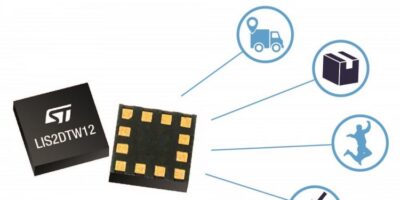ST combines accelerometer and temperature sensor for tight spaces
A MEMS three-axis accelerometer and a temperature sensor are combined in the LIS2DTW12. Available from STMicroelectronics, the single die is designed for use in space-constrained and battery-sensitive detectors such as shipping trackers, wearables, and IoT endpoints. The sensing accuracy of 0.8 degrees C offers precision comparable with standalone standard temperature sensors, according to ST Microelectronics.
The die offers enhanced temperature compensation and the accelerometer’s large range of user modes (65) that can be used by developers to optimise power consumption and noise to meet application-specific requirements. It also has user-selectable full-scale range up to ±16g and measures acceleration with output data rates from 1.6Hz to 1600Hz.
At 0.7mm, the package height is around 30 per cent lower than other combination sensors, estimates ST, allowing the LIS2DTW12 extra battery capacity for longer runtimes. Power-saving features include a 50nA power-down mode, multiple operating modes down to less than one microA, a dedicated internal engine for processing accelerometer signals, and a large 32-level FIFO to reduce intervention from the main controller.
The LIS2DTW12 provides 16-bit accelerometer data and 12-bit temperature data through a high-speed I2C/SPI port, and allows single data conversion on demand. The motion engine performs free-fall and wake up detection, single/double-tap recognition, activity/inactivity, stationary/motion detection, portrait/landscape detection, and 6D/4D orientation. ST’s self-test capability is also built-in to verify the sensor is functioning correctly.
The LIS2DTW12 is specified for operation from -40 to +85 degrees C and available now in the ultra-thin 2.0 x 2.0 x 0.7mm LGA-12 plastic land grid array package.
The company also offers a dedicated adapter board, the STEval-MKI190V1 for use with the STEval-MKI109V3 microcontroller motherboard to connect to a PC running the Unico development graphical user interface (GUI) or a custom application for inspecting the sensor data.




